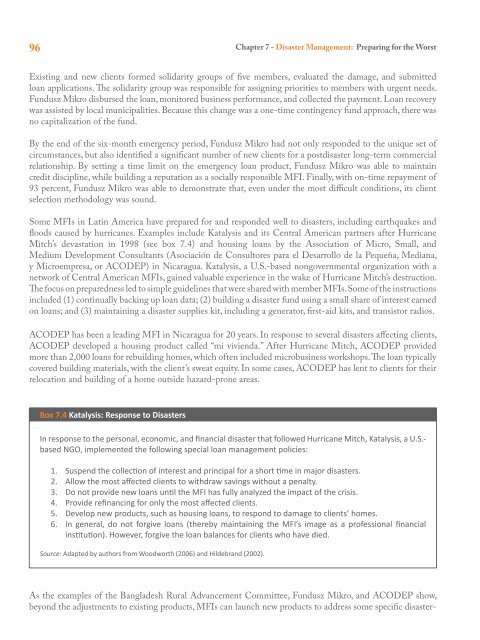managing risk.pdf
managing risk.pdf
managing risk.pdf
Create successful ePaper yourself
Turn your PDF publications into a flip-book with our unique Google optimized e-Paper software.
96 Chapter 7 - Disaster Management: Preparing for the WorstExisting and new clients formed solidarity groups of five members, evaluated the damage, and submittedloan applications. The solidarity group was responsible for assigning priorities to members with urgent needs.Fundusz Mikro disbursed the loan, monitored business performance, and collected the payment. Loan recoverywas assisted by local municipalities. Because this change was a one-time contingency fund approach, there wasno capitalization of the fund.By the end of the six-month emergency period, Fundusz Mikro had not only responded to the unique set ofcircumstances, but also identified a significant number of new clients for a postdisaster long-term commercialrelationship. By setting a time limit on the emergency loan product, Fundusz Mikro was able to maintaincredit discipline, while building a reputation as a socially responsible MFI. Finally, with on-time repayment of93 percent, Fundusz Mikro was able to demonstrate that, even under the most difficult conditions, its clientselection methodology was sound.Some MFIs in Latin America have prepared for and responded well to disasters, including earthquakes andfloods caused by hurricanes. Examples include Katalysis and its Central American partners after HurricaneMitch’s devastation in 1998 (see box 7.4) and housing loans by the Association of Micro, Small, andMedium Development Consultants (Asociación de Consultores para el Desarrollo de la Pequeña, Mediana,y Microempresa, or ACODEP) in Nicaragua. Katalysis, a U.S.-based nongovernmental organization with anetwork of Central American MFIs, gained valuable experience in the wake of Hurricane Mitch’s destruction.The focus on preparedness led to simple guidelines that were shared with member MFIs. Some of the instructionsincluded (1) continually backing up loan data; (2) building a disaster fund using a small share of interest earnedon loans; and (3) maintaining a disaster supplies kit, including a generator, first-aid kits, and transistor radios.ACODEP has been a leading MFI in Nicaragua for 20 years. In response to several disasters affecting clients,ACODEP developed a housing product called “mi vivienda.” After Hurricane Mitch, ACODEP providedmore than 2,000 loans for rebuilding homes, which often included microbusiness workshops. The loan typicallycovered building materials, with the client’s sweat equity. In some cases, ACODEP has lent to clients for theirrelocation and building of a home outside hazard-prone areas.Box 7.4 Katalysis: Response to DisastersIn response to the personal, economic, and financial disaster that followed Hurricane Mitch, Katalysis, a U.S.-based NGO, implemented the following special loan management policies:1. Suspend the collecon of interest and principal for a short me in major disasters.2. Allow the most affected clients to withdraw savings without a penalty.3. Do not provide new loans unl the MFI has fully analyzed the impact of the crisis.4. Provide refinancing for only the most affected clients.5. Develop new products, such as housing loans, to respond to damage to clients’ homes.6. In general, do not forgive loans (thereby maintaining the MFI’s image as a professional financialinstuon). However, forgive the loan balances for clients who have died.Source: Adapted by authors from Woodworth (2006) and Hildebrand (2002).As the examples of the Bangladesh Rural Advancement Committee, Fundusz Mikro, and ACODEP show,beyond the adjustments to existing products, MFIs can launch new products to address some specific disaster-
















